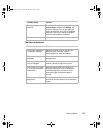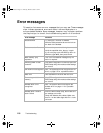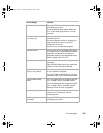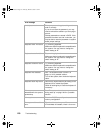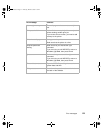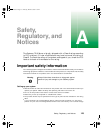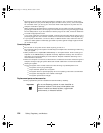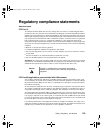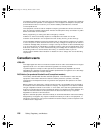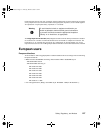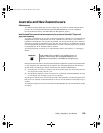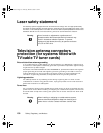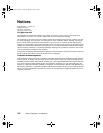
Safety, Regulatory, and Notices 125
Regulatory compliance statements
American users
FCC Part 15
This device has been tested and found to comply with the limits for a Class A digital device,
pursuant to Part 15 of the FCC rules. These limits are designed to provide reasonable protection
against harmful interference in a residential installation. This equipment generates, uses, and can
radiate radio frequency energy and, if not installed and used in accordance with the instructions,
may cause harmful interference to radio or television reception. However, there is no guarantee
that interference will not occur in a particular installation. If this equipment does cause
interference to radio and television reception, which can be determined by turning the equipment
off and on, the user is encouraged to try to correct the interference by one or more of the following
measures:
■
Reorient or relocate the receiving antenna
■
Increase the separation between the equipment and receiver
■
Connect the equipment into an outlet on a circuit different from that to which the receiver
is connected
■
Consult the dealer or an experienced radio/TV technician for help.
■
Use only shielded cables to connect peripherals to the system.
Accessories: This equipment has been tested and found to comply with the limits of a Class A
digital device. The accessories associated with this equipment are: shielded video cable. These
accessories are required to be used in order to ensure compliance with FCC rules.
FCC Part 68 (applicable to products fitted with USA modems)
Your modem complies with Part 68 of the Federal Communications Commission (FCC) rules.
On the computer or modem card is a label that contains the FCC registration number and Ringer
Equivalence Number (REN) for this device. If requested, this information must be provided to
the telephone company.
An FCC compliant telephone line cord with a modular plug is required for use with this device.
The modem is designed to be connected to the telephone network or premises wiring using a
compatible modular jack which is Part 68 compliant. See installation instructions for details.
The Ringer Equivalence Number (REN) is used to determine the number of devices which may
be connected to the telephone line. Excessive REN’s on a telephone line may result in the devices
not ringing in response to an incoming call. In most areas, the sum of REN’s should not exceed
five (5.0). To be certain of the number of devices that may be connected to a line, as determined
by the total REN’s, contact the local telephone company.
If this device causes harm to the telephone network, the telephone company will notify you in
advance that temporary discontinuance of service may be required. The telephone company may
request that you disconnect the equipment until the problem is resolved.
Caution Changes or modifications not expressly approved by
Gateway could void the user’s authority to operate the
equipment.
8505945.book Page 125 Thursday, March 9, 2000 2:13 PM



